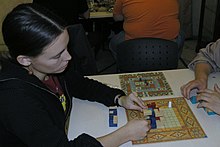| This article does not cite any sources. Please help improve this article by adding citations to reliable sources. Unsourced material may be challenged and removed. Find sources: "Pueblo" game – news · newspapers · books · scholar · JSTOR (November 2021) (Learn how and when to remove this message) |
 | |
| Designers | Wolfgang Kramer/Michael Kiesling |
|---|---|
| Publishers | Ravensburger |
| Players | 2-4 |
| Setup time | 2 minutes |
| Playing time | 30-60 Minutes |
| Chance | None |
| Age range | 10 and up |
| Skills | Strategic thought, Spatial Visualization Ability |
Pueblo is an abstract strategy game which is a competition to optimally place blocks in a constrained space. The name, theme, and artwork for the game derive from the famous architecture of Taos Pueblo, but they are very lightly applied.
Rules
Equipment
A rectangular playing board. Each player has an equal number of colored and neutral blocks, all of which have the same three-dimensional shape. A Chieftain piece, and a scoring track.
Setup
Start with the board empty, the Chieftain in a corner, and with each player's neutral and colored blocks in pairs.
Object
Points are scored when the Chieftain can see any of your colored blocks. The goal of the game is to avoid scoring points.
Play
Play rotates among the players. On each move, place one new block on the board, move the Chieftain, and score the players whose colored blocks are visible to him.
Strategy
The really elementary strategy is to place your blocks behind the Chieftain, but that quickly becomes impossible, as the Chieftain walks all around the board and revisits same viewpoints. The ground level of the board fills up, forcing the players to build upward.
Variants
The advanced version of the game adds Sacred Sites that cannot be built upon.